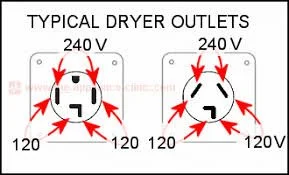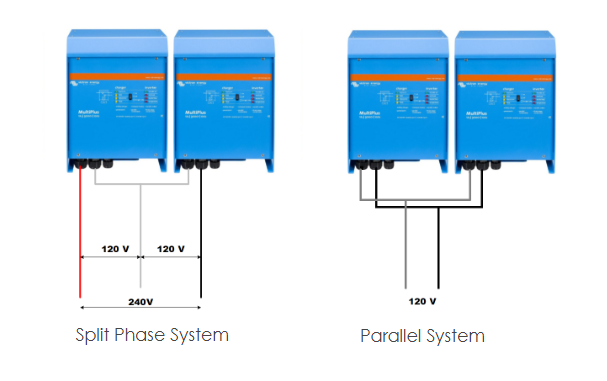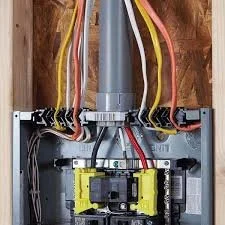120 / 240V AC SPLIT PHASE ELECTRICAL TINY OFF-GRID HOUSE
Image courtesy of iStock
Living off-grid in a Tiny House does not mean one has to make sacrifices or concessions when choosing residential appliances. The only requirement is for the use of ENERGY STAR appliances; which will consume electrical energy more efficiently.
In the off-grid RV & marine world, energy and space constraints have historically forced the use of compact Direct Current (DC) 12 volt appliances. These smaller versions of full-size appliances provides an inconvenient concession.
Image courtesy of The Appliance Clinic
Advances in off-grid energy production, storage and monitoring have enabled the convenient use of regular size, conventional, residential appliances powered by alternating current (AC) at 120 / 240 Volts, 60 Hz (North America); the 240 voltage accommodating appliances: like an induction cooktop, tankless water heater or combo washer / dryer . . . that require double-pole 30, 40 or 50 Amp circuit breakers; respectively. This is achieved by wiring two 120V AC Inverters for a split phase 120 / 230V output. At a minimum, these appliances will be ENERGY STAR rated.
WHAT IS AN INVERTER
An Inverter has 2 main functions relating to incoming DC & AC power: DC power is obtained from the battery bank and transfers it to the main service panel. Also, AC power can be obtained from the shore power (Utility grid) or a generator. An Inverter / Charger has the added capability of charging a battery bank directly with DC to DC power or converting AC to DC power.
Image courtesy of Victron Energy
The Tiny Off-Grid House 120 / 240V, AC , 60 Hz, split phase system will be provided by two stacked 48 Volt Victron Quattro Pure Sine Wave Inverter / Chargers 48V/5000W/70-100/100 (SKU: QUA4850-21010) wired in split phase; creating 180 degree opposite phases. Each identical Quattro generating 120 volts are combine to make 240 volts total. Not to be confused with two 120 volt Quattros wired in “parallel” which simply increases the 120 volt power available.
The Quattro comes in 230 Volts for European systems or a 120 Volts model for North American systems. Victron Energy provides various Inverter / Charger models capable of producing 120 volts and when stacked together can create 120 / 240V AC split phase electrical energy. Three Victron inverters can even be stacked for a 3 phase split phase system. This may seem excessive for a residential Tiny Off Grid House but not for one designed as a “Tiny Off Grid Mechanical Work Shop.”
All-in-one 120 / 240V split phase inverters / chargers are convenient but the lack of modularity makes repairs, upgrades or expansions difficult. A modular design allows flexibility to isolate individual components for repair or upgrades.
Communications between the Quattros are enabled through a RJ 45 cable series connected to each respective inverter VE Bus port and a Victron Cerbo GX for advanced system monitoring and data logging.
The Quattro does not have an integrated MPPT solar charge controller; unlike other Victron models, so an external solar charge controller will be required to harness the power from the solar array. This may not be a disadvantage because it allows for modulation and upgrades.
Image courtesy of The Home Depot
MAIN SERVICE PANEL SERVICE CONDUCTORS
One L1 (Black) and one L2 (Red) hot service conductor’s, with Neutral (White) conjoined conductors all of equal lengths, exiting their respective inverters “AC OUT” ports, will provide 120 / 240V AC power to the main service panel (MSP) L1, L2 terminals and parallel Neutral bars.
Black and red conductors of equal length, from their respective inverter / charger battery - & + connection ports will connect to a Victron Lynx Distributor where it will obtain DC power from the Lithium battery bank. (For smaller 3K systems use a bus bar with overcurrent protection).
A Quattro will straddle each side of the MSP with atleast 4” - 6” of space in between to facilitate cooling.
According to the National Electrical Code, the Main Service Panel (MSP) or the first means of disconnection is where the Neutrals and Grounding conductors are bonded; along with a green bonding screw. However, since the current Inverter / Charger program allows one of the two Victron inverters to create an internal Neutral & Ground Electrode Conductor (GEC) bond the Neutrals and GEC conductors in the MSP have to remain separated; unbonded, along with the green bonding screw detached (2023 NEC 250.32(B)(1). This feature allows the AC input and Grid Assist features to function properly along with the use of AC bypass if you have an AC input feeding a load. The cons of generating 120 / 240 volt split phase from two identical inverter / chargers is that each leg (L1 & L2) will only receive power from their respective inverter / charger. That is why it is imperative that the MSP circuit breakers loads are arranged to balance the L1 & L2 sides of the MSP; since there is no way for the inverter / charger supplying the L1 side to help supply the L2 side, or the inverse, if it has a larger electrical load.
Please share your thoughts or experiences in the Comments section below.



